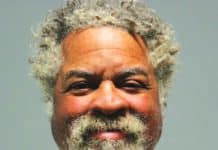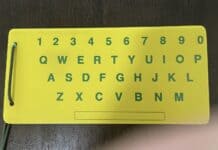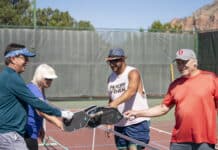One of the least known yet fastest growing sports in the nation has a place to call home in Sedona.
The Sedona Pickleball Club, which plays at Posse Grounds Park, is a group of players who have been playing for one to three years, and mostly consists of players from the Baby Boomer generation.
“Pickleball is the fastest growing sport in America,” Bob McCormick, a member and club ambassador to the USA Pickleball Association, said. “It shouldn’t be viewed as slow tennis. It’s actually faster than tennis at the ‘kitchen’ line, where players of all pickleball levels can engage in fast-paced exchanges.”
Created in 1965, pickleball, aside from its obvious health benefits, provides a good opportunity for players to form new friendships.
“I like the social aspect of it,” said Patti Childers, another of the club’s ambassadors. “It’s a very social game. A lot of tourists come through that do know how to play and some that are just learning. A lot of people bring their visiting friends
and teach them.”
On the USAPA website, players can see where the sport is played in the area to which they travel.
In Sedona, pickleball was first played at Sunset Park in 2013, where lines were drawn on one of the basketball courts and two games could be played at once. Since 2015, the club has played at the Posse Grounds Park, and the club converges at 10 a.m. every Tuesday and Thursday through Sunday, and at 2 p.m. Tuesday, Thursday, Friday and Sunday.
Each session lasts between two and three hours, according to Childers, and normally between 16 and 20 people turn up to play. However, more than 100 people are on the club’s roster.
Since the club was formed, the Parks and Recreation department paid $2,500 to paint lines and provide nets for four courts as well as minor maintenance at Posse Grounds Park due to an increase in popularity. One pickleball court occupies the space of one-fourth of a tennis court.
“I think the increase came when [the club] was given the facility to use,” Rachel Murdoch, Parks and Recreation manager, said. “We were willing to create an amenity for the park and gave the time slots.”
Childers said that because pickleball is a relatively easy sport to learn, especially for anyone with experience playing tennis or racquetball, they would find new players by simply inviting in passersby and giving them a racket.
After three to six months most players notice a marked improvement, according to Childers.
“It’s a really fun sport,” she said. “It doesn’t take a lot of athleticism; anyone can learn. People who’ve never played any racket sports or ping pong can play really well in a short amount of time.”
The club has also hosted clinics to grow the players’ knowledge and skills.
“It’s for people of any age, it’s fun and you get good exercise,” Steve Mandelbaum said. “Especially for people getting up there in age. It’s relatively easy.”
The hardest part, says Mandelbaum, is “staying out the kitchen.” The ‘kitchen’ is the area of the court extending seven feet from either side of the net where players are not allowed to step or even allow their momentum to carry them inside of when volleying the ball.
Using a racket that draws comparison to an oversized ping pong paddle and a whiffleball, play is usually done in doubles, but singles or even a three-player variation are possible. Games are played to 11 points and are won by a margin of at least two points.
The sport is also safe compared to its larger counterpart, tennis, due to the smaller court size.
While the club does not attend competitions as a whole, some players have competed in Cottonwood, and McCormick said he attends the USAPA Nationals, held annually in Casa Grande.
The club has rackets for interested newcomers to use, and a typical racket can cost anywhere between $10 and $100. There is a $10 annual fee to join the club, with the money going toward the purchase of balls.
There will be three dedicated pickleball courts at the new park to be built off Brewer Road, according to Murdoch, but no formal date of completion has been set because the park is still in the planning phase.
For more information, Childers can be reached at 707-4887 and McCormick at (765) 426-1254. The city’s Parks and Recreation website has information as well.




















